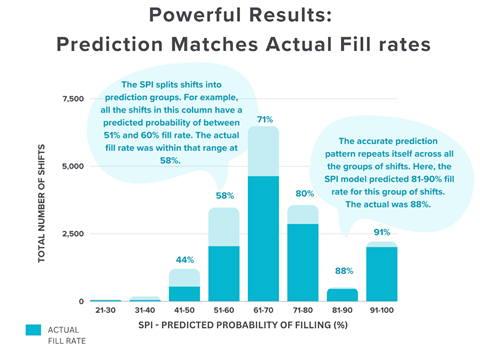Dr Nicholas Andreou explores how Locum’s Nest are innovating to higher levels by leveraging machine learning to maximise NHS shift fill rates.
What if I were to tell you that alongside our NHS partners, we have developed an artificial intelligence model which can tell, at any given time, the probability of finding someone to work a bank shift?
Sponsored by
What if I were to tell you that this algorithm makes better decisions than humans when deciding which shifts to cascade to agencies and escalate the rates of (and by how much), resulting in massive savings and higher fill rates?
Would you go as far as saying that this innovation, if used wisely, could be the single most important leap forward in the history of the NHS workforce planning, since the invention of rota planning on spreadsheets?
Before we make such claims, let me take you on the journey that our research and development team went through in the past few years.
A technological leap forward: The birth of the Shift Popularity Index
At Locum’s Nest, we develop shift-matching software so that NHS organisations can effectively manage their contingent workforce, vacant shifts, and the enormous budgets that come with them. Our culture focuses on continued innovation, so we allocate a significant budget to research and development. In one of our typically sci-fi-themed research and development meetings, we made a hypothesis: the vast number of our shift data holds a treasure trove of insights that a human brain would struggle to comprehend.
This led us to start developing our own Machine Learning model, attaching a popularity index to each shift, a prediction score of sorts that could predict a shift’s chances of being filled. Our Shift Popularity Index uses learning and predictive analytics technologies to predict the fill rates of shifts posted by employers, at the point of posting.
The SPI uses past data to accurately predict whether a future shift will be filled or not
After training our model on hundreds of thousands of shifts and all their data points from the past six years, we developed an algorithm that can accurately predict the probability of filling a shift. The more data we feed through it, the better, as the model improves its accuracy over time.
We recently tested the accuracy of the model with around 20,000 recent shifts across multiple hospitals up and down the country. The result: the model was remarkably impressive in accurately predicting actual fill rates.

Optimising Shift Rates: The SPI saves £175,000 per trust every three months by having superior decision-making capabilities when compared to humans
We thought, given the model’s accuracy, what if we could simulate the effects of changes in shift variables on the fill rate, such as increases or decreases in a shift’s pay rate?
We started by taking shifts with a high probability of getting filled (a high SPI Score) and reran them through the model with standard rates instead of escalated rates - the change in fill rate was negligible (-0.5 per cent) but represented an astonishing 30 per cent in savings.
We then reallocated some of the savings to shifts with a lower probability of getting filled and escalated their rates. After re-running the simulation, the results were an impressive ~45 per cent increase in fill rates for shifts with a low SPI score.
The possibilities are endless: We’re going public with these findings because the world should know!
In a modern world where public and household budgets are stretched, where the NHS workforce is further stretched, we must harness innovative technology such as the SPI to help make the best allocation of those scarce resources.
The lessons from this simulation are revealing, but should come as no surprise: humans, without rich data, do a poor job at predicting the future. With the help of advanced data-driven tools such as the SPI, humans can make more informed decisions and save tons of time and money in the process. Escalating bank shift rates for hard-to-fill shifts, whilst being an ancient NHS art, has until now, been based on human intuition and artificial rate card ceilings. The era of turning art into science and harnessing the power of data to make budget decisions is not only theoretical but demonstrated beautifully through our proprietary SPI technology.
Given more money is unlikely to be made available to help staff the NHS immediately, we should be focusing on optimising how we allocate our current resources. The SPI is a brilliant example of how an AI system can aid humans to instantly enhance hospital staffing at a fraction of the cost.
The SPI is available to all Locum’s Nest partner NHS organisations. For more information on how it can be deployed in your organisation, contact me directly.

Three techniques to improve fairness in the way you deploy your contingent workforce
Central and North West London NHS FT adopts Locum’s Nest total workforce solution to revolutionise flexible working and collaborative rostering across medics and Allied Health Professionals
University College London Hospital, Moorfields and Great Ormond Street, to form the capital’s largest medical collaborative staff bank, comprising 10 London trusts part of the North Central London STP






























